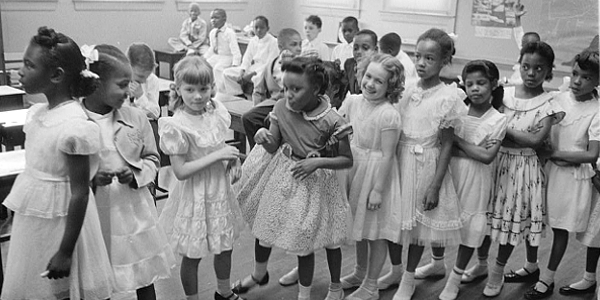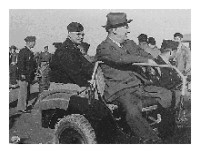-
Timeline - The 1950s
It was a time for chickens in every pot, two cars in every garage, color television, another war, and a space race to the stars.
More 1900s

View of Disneyland in 1956.

Rosa Parks transit bus now on display at the Henry FordMuseum, a National Historic Site, in Dearborn, Michigan.
Timeline Book

Now in easy to search digital format for your Kindle, Nook,or pdf format. Also comes in paperback, too.
ABH Travel Tip

A visit to Eisenhower National Historic Site should not be missed if you are visiting Gettysburg. Its home and farm evoke the time of the general and his wife, with period furnishings and tales of not only his presidency and the meetings with world and national leaders at the farm, but his life in Gettysburg and prior to that, in World War II. The farm was the only home Eisenhower owned in his lifetime.
Sponsor this page. Your banner or text ad can fill the space above.
Click here to Sponsor the page and how to reserve your ad.
- Timeline
Detail - 1955
May 31, 1955 - The Supreme Court of the United States orders that all public schools be integrated with deliberate speed.

It would take one more year after the ruling in Brown vs. Board of Education for the Supreme Court to hear arguments on how the initial ruling would take practical effect. Despite the ruling in Brown I that segregation in public schools was illegal, many all white schools had not acted upon the order as 1955 began. The Supreme Court had predicted as much, setting aside time in the next court session to consider the arguments and make a ruling about how implementation would occur.
For four days starting April 11, 1955, the Supreme Court heard arguments on how integration would or should happen. While the basis for this would be that segregation was unconstitutional, the exact implementation for each state or school district was that they should act in good faith toward that goal and that a court would decide what good faith action was. Oral arguments were heard from the various parties from the United States, Florida, North Carolina, Arkansas, Oklahoma, Maryland, and Texas. The NAACP (National Association for the Advancement of Colored People) argued that these actions, integration, should occurr immediately. The states argued that the complexity of the situation called for more time.
Some states and districts had already taken steps to integrate, including Topeka, Kansas, who did not wait for Brown II to be issued, with substantial progress in Delaware and the District of Columbia. Even before the issuance of the 1954 ruling, Topeka had, by August 1953, integrated two elementary schools. Full integration in Topeka elementary schools was completed by 1956.
On May 31, 1955, Supreme Court Chief Justice Warren read the ruling of Brown II. That decision was unanimous. All states must end segregation practices with "all deliberate speed." However, the Supreme Court placed no deadline on that, when that desegration must occur. The district courts would be given the authority to decide, on a case by case basis, whether a district was in compliance.
The ruling with its vague timetable caused problems going forward. Some southern schools did not integrate for years. It is estimated that only 1.2% of black children in the former Confederate States were integrated into white schools within ten years. One of those that did not respond favorably was in Little Rock, Arkansas. At Little Rock Central High School in 1957, the state's governor, Orval Faubus, sent the state national guard to block black students from entering; President Eisenhower responded with the 101st Airborne, allowing them to enter. Some cities, such as Greensboro, North Carolina, took until 1971 to fully integrate.
Today you can visit several National Park Service sites that tell the story of Brown versus the Board of Education and its subsequent application. In Topeka, Kansas, the Brown v Education National Historic Site includes exhibits on Race and the American Creed, the court case, and Education and Justice. In Little Rock, Arkansas, the Little Rock Central High School National Historic Site has tours and exhibits on the 1957 action of the federal government to force enforcement of Brown v Education.
Full Text, Implementation Decree
Supreme Court of the United States
No. l , October Term, 1954.
Oliver Brown, Mrs. Richard Lawton, Mrs. Sadie Emmanuel et al., Appellants,
VS.
Board of Education of Topeka, Shawnee County, Kansas, et al.
Appeal from the United States District Court for the District of Kansas.
This cause came on to he heard on the transcript of the record from the United States District Court for the District of Kansas, and was argued by counsel.
On consideration thereof, It is ordered and adjudged by this Court that the judgment of the said District Court in this cause be, and the same is hereby, reversed with costs; and that this cause be, and the same is hereby, remanded to the said District Court to take such proceedings and enter such orders and decrees consistent with the opinions of this Court as are necessary and proper to admit to public schools on a racially nondiscriminatory basis with all deliberate speed the parties to this case.
Per Mr. Chief Justice Warren,
May 51, 1955.

Image above: Photo of school integration at the Barnard School in Washington, D.C., May 27, 1955, Thomas J. O'Hallaran, U.S. News and World Report Magazine Photograph Collection at the Library of Congress. Image below: Supreme Court members, December 14, 1953. Back row, Tom Clark, Robert H. Jackson, Harold Burton, Sherman Minton. Front row, Felix Frankfurter, Hugo Black, Chief Justice Earl Warren, Stanley Reed, William O. Douglas, 1953, United Press International. Courtesy Library of Congress. Source Info: Ourdocuments.gov; National Park Service; Brown v. Board of Education of Topeka, Implementation Decree; May 31, 1955; Records of the Supreme Court of the United States; Record Group 267; National Archives; Supreme.justia.com; "
Documents Related to Brown v. Board of Education," 2000, Mary Frances Greene, National Archives and Records Administration; "From policy to practice: Remembering Brown II," 2012, Abigail Perkiss, Constitutioncenter.org; Wikipedia Commons.

History Photo Bomb

Korean War bombing raid. Courtesy National Archives.
About
America's Best History where we take a lookat the timeline of American History and the historic sites and national parks that hold that history within their lands.
Photos courtesy of the Library of Congress, National Archives, National Park Service, americasbesthistory.com & its licensors.

